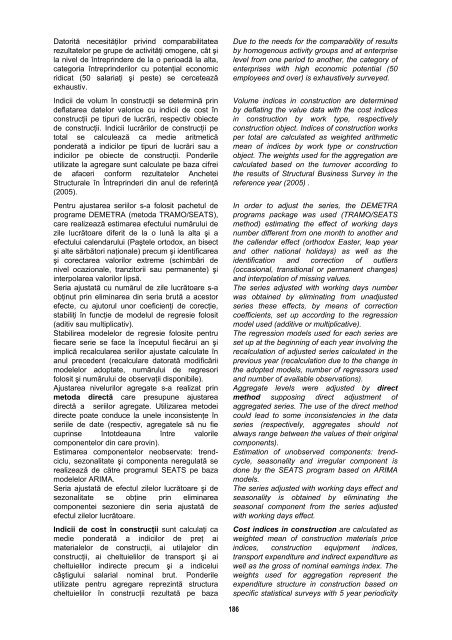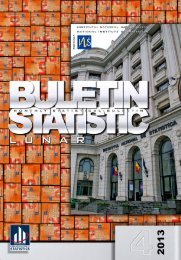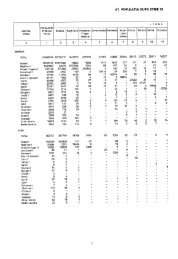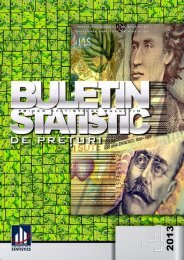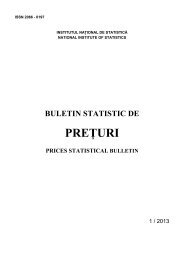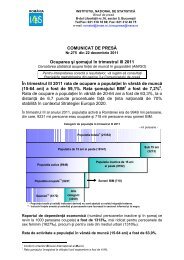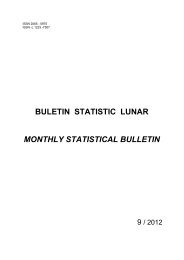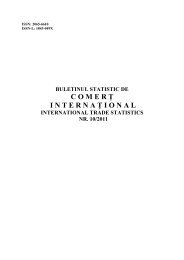BULETIN STATISTIC LUNAR MONTHLY STATISTICAL BULLETIN
BULETIN STATISTIC LUNAR MONTHLY STATISTICAL BULLETIN
BULETIN STATISTIC LUNAR MONTHLY STATISTICAL BULLETIN
You also want an ePaper? Increase the reach of your titles
YUMPU automatically turns print PDFs into web optimized ePapers that Google loves.
Datorită necesităţilor privind comparabilitatea<br />
rezultatelor pe grupe de activităţi omogene, cât şi<br />
la nivel de întreprindere de la o perioadă la alta,<br />
categoria întreprinderilor cu potenţial economic<br />
ridicat (50 salariaţi şi peste) se cercetează<br />
exhaustiv.<br />
Indicii de volum în construcţii se determină prin<br />
deflatarea datelor valorice cu indicii de cost în<br />
construcţii pe tipuri de lucrări, respectiv obiecte<br />
de construcţii. Indicii lucrărilor de construcţii pe<br />
total se calculează ca medie aritmetică<br />
ponderată a indicilor pe tipuri de lucrări sau a<br />
indicilor pe obiecte de construcţii. Ponderile<br />
utilizate la agregare sunt calculate pe baza cifrei<br />
de afaceri conform rezultatelor Anchetei<br />
Structurale în Întreprinderi din anul de referinţă<br />
(2005).<br />
Pentru ajustarea seriilor s-a folosit pachetul de<br />
programe DEMETRA (metoda TRAMO/SEATS),<br />
care realizează estimarea efectului numărului de<br />
zile lucrătoare diferit de la o lună la alta şi a<br />
efectului calendarului (Paştele ortodox, an bisect<br />
şi alte sărbători naţionale) precum şi identificarea<br />
şi corectarea valorilor extreme (schimbări de<br />
nivel ocazionale, tranzitorii sau permanente) şi<br />
interpolarea valorilor lipsă.<br />
Seria ajustată cu numărul de zile lucrătoare s-a<br />
obţinut prin eliminarea din seria brută a acestor<br />
efecte, cu ajutorul unor coeficienţi de corecţie,<br />
stabiliţi în funcţie de modelul de regresie folosit<br />
(aditiv sau multiplicativ).<br />
Stabilirea modelelor de regresie folosite pentru<br />
fiecare serie se face la începutul fiecărui an şi<br />
implică recalcularea seriilor ajustate calculate în<br />
anul precedent (recalculare datorată modificării<br />
modelelor adoptate, numărului de regresori<br />
folosit şi numărului de observaţii disponibile).<br />
Ajustarea nivelurilor agregate s-a realizat prin<br />
metoda directă care presupune ajustarea<br />
directă a seriilor agregate. Utilizarea metodei<br />
directe poate conduce la unele inconsistenţe în<br />
seriile de date (respectiv, agregatele să nu fie<br />
cuprinse întotdeauna între valorile<br />
componentelor din care provin).<br />
Estimarea componentelor neobservate: trendciclu,<br />
sezonalitate şi componenta neregulată se<br />
realizează de către programul SEATS pe baza<br />
modelelor ARIMA.<br />
Seria ajustată de efectul zilelor lucrătoare şi de<br />
sezonalitate se obţine prin eliminarea<br />
componentei sezoniere din seria ajustată de<br />
efectul zilelor lucrătoare.<br />
Indicii de cost în construcţii sunt calculaţi ca<br />
medie ponderată a indicilor de preţ ai<br />
materialelor de construcţii, ai utilajelor din<br />
construcţii, ai cheltuielilor de transport şi ai<br />
cheltuielilor indirecte precum şi a indicelui<br />
câştigului salarial nominal brut. Ponderile<br />
utilizate pentru agregare reprezintă structura<br />
cheltuielilor în construcţii rezultată pe baza<br />
Due to the needs for the comparability of results<br />
by homogenous activity groups and at enterprise<br />
level from one period to another, the category of<br />
enterprises with high economic potential (50<br />
employees and over) is exhaustively surveyed.<br />
Volume indices in construction are determined<br />
by deflating the value data with the cost indices<br />
in construction by work type, respectively<br />
construction object. Indices of construction works<br />
per total are calculated as weighted arithmetic<br />
mean of indices by work type or construction<br />
object. The weights used for the aggregation are<br />
calculated based on the turnover according to<br />
the results of Structural Business Survey in the<br />
reference year (2005) .<br />
In order to adjust the series, the DEMETRA<br />
programs package was used (TRAMO/SEATS<br />
method) estimating the effect of working days<br />
number different from one month to another and<br />
the callendar effect (orthodox Easter, leap year<br />
and other national holidays) as well as the<br />
identification and correction of outliers<br />
(occasional, transitional or permanent changes)<br />
and interpolation of missing values.<br />
The series adjusted with working days number<br />
was obtained by eliminating from unadjusted<br />
series these effects, by means of correction<br />
coefficients, set up according to the regression<br />
model used (additive or multiplicative).<br />
The regression models used for each series are<br />
set up at the beginning of each year involving the<br />
recalculation of adjusted series calculated in the<br />
previous year (recalculation due to the change in<br />
the adopted models, number of regressors used<br />
and number of available observations).<br />
Aggregate levels were adjusted by direct<br />
method supposing direct adjustment of<br />
aggregated series. The use of the direct method<br />
could lead to some inconsistencies in the data<br />
series (respectively, aggregates should not<br />
always range between the values of their original<br />
components).<br />
Estimation of unobserved components: trendcycle,<br />
seasonality and irregular component is<br />
done by the SEATS program based on ARIMA<br />
models.<br />
The series adjusted with working days effect and<br />
seasonality is obtained by eliminating the<br />
seasonal component from the series adjusted<br />
with working days effect.<br />
Cost indices in construction are calculated as<br />
weighted mean of construction materials price<br />
indices, construction equipment indices,<br />
transport expenditure and indirect expenditure as<br />
well as the gross of nominal earnings index. The<br />
weights used for aggregation represent the<br />
expenditure structure in construction based on<br />
specific statistical surveys with 5 year periodicity<br />
186


